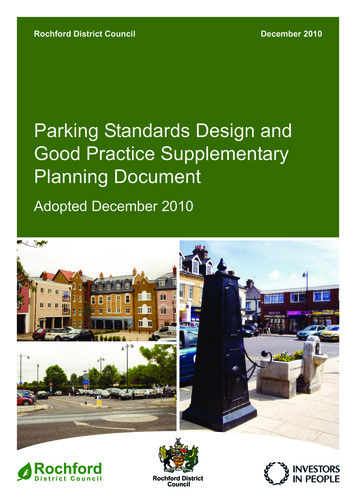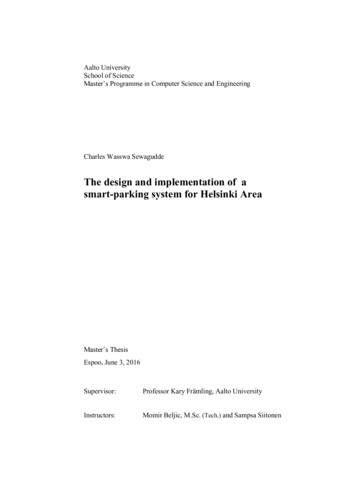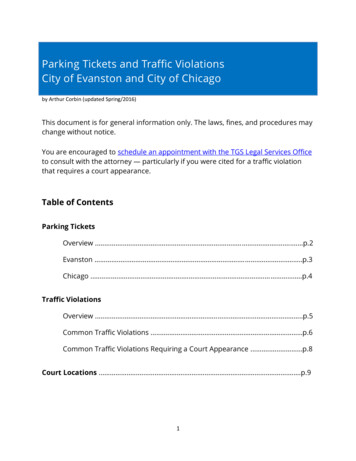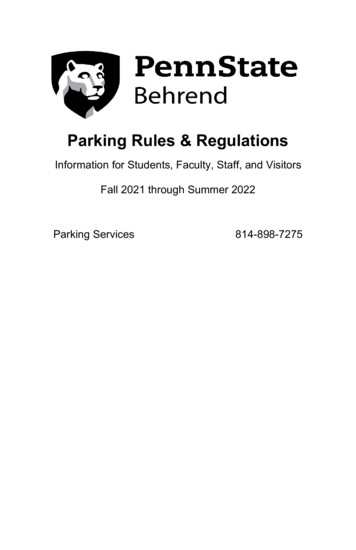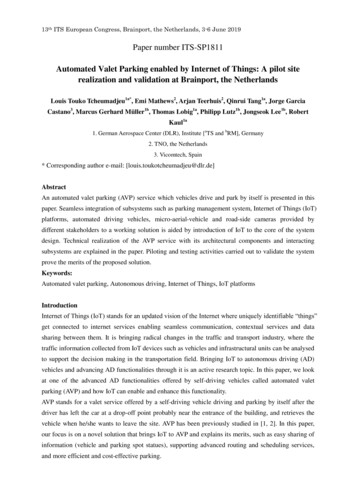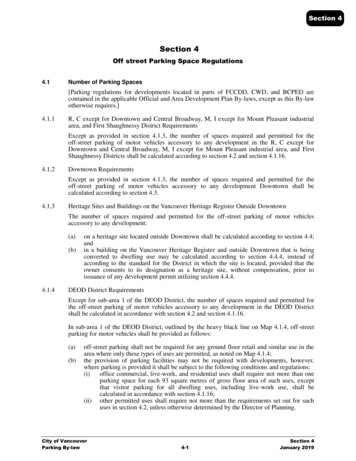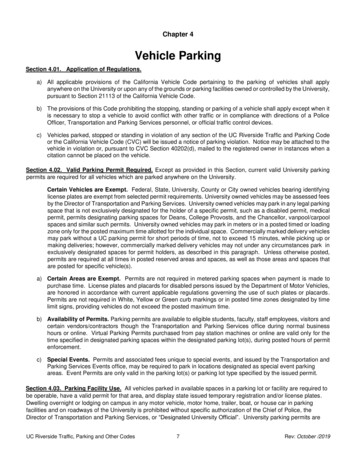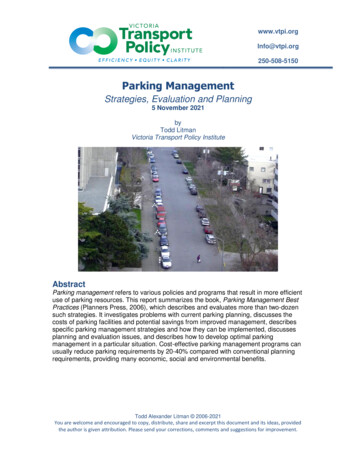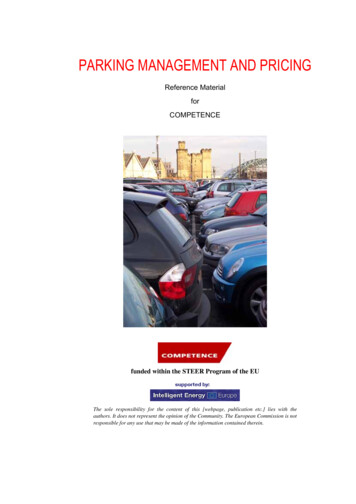
Transcription
PARKING MANAGEMENT AND PRICINGReference MaterialforCOMPETENCEfunded within the STEER Program of the EUThe sole responsibility for the content of this [webpage, publication etc.] lies with theauthors. It does not represent the opinion of the Community. The European Commission is notresponsible for any use that may be made of the information contained therein.
For the use of the following material:The aim of this material is to strengthen the knowledge of local / regional managing agencies inthe transport field and to accelerate the take up of EU research results in the field of local andregional transport. The beneficiaries of the project are managing (energy) agencies who want toplay a bigger role in the transport field.Due to the size and (in some cases) the number of individual projects, it is not possible toexplain each single result in detail and include it into these written materials.The following set of material should rather act as a portal and facilitate the access of singleprojects and detailed results.Therefore the material in hand doesn't lay claim to completeness.The following compendium contains results of EU research-projects and complementary resultsof national research-projects. The authors thank the partners and collaborators of the COST 342project. A complete list of the projects, consortia, and cited literature is given at the end of thematerial.The material for the topic “Parking Management and Pricing” was compiled by Tom RYE(Napier University, Edinburgh) for the STEER training project COMPETENCE in 2006.Parking Management and PricingReference Material from COMPETENCE / TREATISE / E-ATOMIUMI
Table of Contents1.Introduction. 1Learning outcomes .12.Parking: some basic concepts . 32.12.22.32.4Parking Demand .3Types of parking.3On-street Parking .4Regulating on-street parking.4Enforcement .52.52.62.72.8How much does it cost to park on-street in different countries in the EU? .6Off-street parking .7Experiences of parking price changes and zoning in town centres .8Relationship between parking and public transport use policies to encourage publictransport.82.9 Park and Ride.9Costs .102.10 Company parking space management .113.Relationship between parking and economic development. 134.Relationship between parking and planning and transport objectives . 154.14.24.34.44.55.Introduction.15Development of a typical parking policy .15Other examples of parking policies in action .17The politics of introducing parking policies: gaining acceptance .17Parking and land use planning.18Conclusions and Recommendations . 235.1 Recommendations .235.2 Final conclusions .24References .246.Literature and Websites . 25Parking Management and PricingReference Material from COMPETENCE / TREATISE / E-ATOMIUMII
1. IntroductionThis Unit in COMPETENCE is about parking pricing and management. It draws on a numberof key sources: the 2005 final report of the European COST 342 project on parking; LEDA(http://www.leda.ils.nrw.de/); CIVITAS (http://www.civitas-initiative.org/main.phtml?lan en);the limited academic literature on the topic; and policy and policy evaluation fromwww.vtpi.org, level0/l0 hom.htm , and fromthe UK generally. The author of this Unit is UK based and so this goes some way to explainingwhy quite a few of the examples and cases are from the UK. However, the COST 342 materialincludes many examples from other European countries. A link to it is provided on theCOMPETENCE website, and it is commended to you.The availability and cost of a parking space is an important determinant of whether or notpeople choose to drive to a particular destination, and also whether they choose to own a car atall – it is likely that the relatively lower levels of car ownership in many inner cities (in spite oftheir greater wealth relative to other areas) are partly a result of the lack of on-street parking (sonowhere to put a car), as well as the above average levels of public transport accessibility.Local authorities have direct control over the use of kerbspace (other than on trunk roads) intheir areas, and therefore of the supply and price of on-street parking. Many authorities ownpublic off-street car parks, over whose use and price they also have control (although the extentto which they are the provider of public off-street parking varies from locality to locality).Through the development control process, they also have some control over the level of parkingthat is provided in new developments.Whilst parking controls and prices are rarely popular with the public, they are a policy optionthat is relatively well-known and, certainly in larger towns and cities, accepted – if there is anobvious shortage of parking spaces then many people may accept that there is a need for parkingcontrols. Parking controls and pricing are the transport demand management measure that ismost frequently implemented by local authorities, yet little of the academic literature deals withexperience of this policy, preferring instead to concentrate on the “sexier” topic of congestioncharging. This Unit attempts to redress that balance a little.Learning outcomesOnce you have worked your way through this unit, including the self assessment questions, youshould be able to: understand the relationship between parking, revenue raising and economic development understand how and why local parking policies are developed, and be able to criticallyapply your understanding to a case study understand the circumstances in which it may be appropriate to use parking policy as ademand management tool.Parking Management and PricingReference Material from COMPETENCE / TREATISE / E-ATOMIUM1
Car parking is an issue of significance both at the local and at the strategic level of planning.Parking policy and supply play a major role in the management of transportation systems indense urban areas. In order for parking policy decisions to be well founded, the analysis ofparking behaviour and the effect of parking policies should be fully integrated with the otherelements of the transport planning process (Young et al, 1991).Parking policy has traditionally been viewed as a subset of transport policy. It is now recognisedthat parking policy has a key role to play in integrated transport strategies, which seek to exploitthe importance of parking in influencing the overall pattern of travel. An increasing recognitionof the importance of the links between parking policy and other urban policies has evolved, tothe extent that parking policy is now being used to meet a wide range of urban goals.Parking Management and PricingReference Material from COMPETENCE / TREATISE / E-ATOMIUM2
2. Parking: some basic conceptsThis chapter introduces some basic concepts and definitions in parking before we move on toconsider different types of policy that can be pursued by local authorities to manage parking.2.1 Parking DemandUsers of parking facilities constitute more than half the population and this proportion isgrowing: the EUROSTAT online transport statistics database shows that the number of cars per1000 population in the EU25 rose from 394 in 1995 to 463 in 2002 (a rise of 16%). The car isthe dominant mode of transport accounting for nearly 75% of all passenger kilometres in theEU25.There are currently (2003) more than 212 million cars in the EU25, up from over 64 million in1970 (EUSTAT, 2005). There are only two places where these vehicles can be found: they areeither on-street or off-street. If they are on-street, they can be considered to be parked, searchingfor parking or in transit. Almost all cars that are off-street will be parked. Estimates show thatcars spend more than 95% of their lives parked (Collins 1991).In transport terms, demand is usually measured by observing activity: for example, traffic flowsalong a route, or parking acts at a site. In “uncontested” conditions, where the space availableequals or exceeds the demand, then demand is equal to the observed consumption. In“contested” conditions, where there is competition for space, the observed activity orconsumption is constrained; it does not measure the potential demand because some drivershave either been priced out of the market or physically excluded by a shortage of space. It is inthis second contested context that controls must often be introduced.2.2 Types of parkingThere are four main types of parking – places that you can park a car. These are: On-street. As its name suggests, a parking space on the public road. Public off-street. A car park not on the public road, in which any member of the public canpark their car, subject to complying with any regulations (e.g. maximum stay (in hours), orpaying a fee). This kind of car park may be owned and/or operated by the public and/orprivate sector. Private non-residential off-street. This is car parking that is associated with a particularbuilding or land-use – parking for a shopping centre, or an office-building. Only peoplewho are connected with that building or land-use should, in theory, be able to use theparking, and the land-owner has control over this use (within legal constraints in themember state concerned). Private residential parking – off-street parking associated with houses or flats. In theory,only the residents of these houses or flats should be able to use the parking.The pattern of parking supply in our towns and cities in recent years has been in a state ofcontinuous evolution as parking demand has increased. From the outset, this has beenParking Management and PricingReference Material from COMPETENCE / TREATISE / E-ATOMIUM3
influenced by the public and private organisations involved in providing parking infrastructure.It is worth remembering the basic types of parking and the degree to which local authoritieshave control over them. The major distinction when considering parking supply is that betweenparking provided on-street and that provided off-street as shown in Table licPublic or ublicPrivatePricedPublicFreePricedTable 2.1 - Parking Type and the sector controlling and/or supplying it2.3 On-street ParkingOn-street parking is all publicly owned and is provided by local authorities in Europe under thegeneral guidance of central government. Local authorities determine which restrictions shouldapply in specified streets, within central government guidelines, taking into account the nationaland local pressures for road safety, traffic flow, public transport provision and movement, thefunctioning of the local economy, the needs of residents and access for emergency services. Inthe many countries, they must involve the local community in the process of introducingparking restrictions, and communicate the changes effectively to local road users; we return tothis topic later in the unit when we consider how to build acceptance for parking policy changes.The extent to which unregulated kerb space is used for parking is determined by the demand ofthe area and the availability of off-street alternatives. Local authority restrictions will generallyonly apply when supply is exceeded by demand in a particular area (Balcombe and York, 1993),or where safety problems are caused by parking (e.g. sightlines at junctions are restricted).2.4 Regulating on-street parkingIn almost all Western European countries, the local authority decides on the parking regulationsthat go on street. There is a general tendency for on-street parking regulations to become morestringent (restrictive), the closer that one goes to the centres of towns and cities – because theseare the areas of greatest demand. The vast majority of on-street spaces in a given member-stateremain un-regulated in any way, because there is little or no demand for them. But, as demandincreases, some typical restrictions that might be found include: No parking at any time around the mouths of junctions in order to ensure sightlines forvehicles, and safety and access for pedestrians crossing. Parking restrictions on main roads at peak hours to facilitate traffic flow. Parking restrictions on one side of a narrow road to permit two-way traffic flow. Time limited on-street parking in order to facilitate the turnover of parking spaces – usuallyto ensure that short term parkers (e.g. shoppers) can get a space. Parking restrictions in certain areas to provide kerb space so that commercial vehicles canload and unload to service shops and offices alongside the road.Parking Management and PricingReference Material from COMPETENCE / TREATISE / E-ATOMIUM4
Time limits around stations (e.g. no parking 1300-1400 weekdays) to stop informal parkand ride.Where parking problems become more severe, a typical response is to introduce some form ofparking restriction to give residents sole or preferential access to limited on-street parkingaround their homes. COST 342 (pp 336-38) cites the implementation of “blue-zones” or “discparking zones” as a means to do this. They have been introduced in Switzerland, theNetherlands, the UK and Spain, amongst other locations. In Madrid, the local interpretation of ablue-zone is to mark out a high proportion of on-street parking spaces in the central area in blue.These spaces may then be used (time-unlimited) by residents who have a permit; or by otherdrivers, on payment of a charge, but only for a few hours at a time.EnforcementIf parking regulations are to be effective, they must be enforced – otherwise, they will fall intodisrepute. In many cases, however, as noted in COST 342 p 30, and by the LEDA project, localauthorities are, at least partially, dependent on the police for enforcing these regulations. But inAustria, Czech Republic, Finland, France, Netherlands, Norway, Portugal and Spain, localauthorities have powers to take over some enforcement from the police if they can (althoughonly in the Netherlands and the UK is there complete local authority independence in parkingenforcement; in all other countries, the involvement of at least one other agency is required(which can make enforcement less efficient). Here, parking regulations can be enforced underlaw that is not criminal and that can, therefore, be enforced by bodies other than the police,including private sector operators working under contract to the local authority (except inFinland, where such contracting out is illegal). In all cases, this has significantly enhanced thequality of enforcement, and in the UK it has also generated considerable income for some localauthorities. Further details of the UK situation – which is cited as a good practice case study inCOST 342 - are provided in the following paragraphs.Under the 1991 Road Traffic Act, local authorities are able to take over responsibility for onstreet parking enforcement in their areas from the police, but such Special Parking Areas (SPAs)must be self-funding, with operating costs paid for from fines. Thus, CPZs are normally limitedto those areas where it is anticipated that they will run at a profit – mostly areas where demandis significantly greater than supply. The introduction of area wide controls - a CPZ - usuallyinvolves some non-essential users such as commuters being displaced to create additional spacefor essential users such as residents, shoppers and short term business users. Problems may ariseif the displaced users continue to park, but just outside the controlled area; this may result inparking pressure near the boundary of the zone. A CPZ will normally include: Parking spaces for residents only. To park in these, residents’ must buy an annual permit,which cost between 15 and 400 per year, depending on the town or city. Pay and display public parking. Parkers must estimate the length of time that they will stayin the space, and buy a ticket for that length of time, as soon as they park, and display it intheir car. Hourly rates vary from 0.50 to 7.00. Space for loading, but not parking. Space where no parking or loading is allowed (e.g. around junctions, at bus stops).If a parker contravenes any of the regulations, the local authority (or its contractor) can levy afine. This varies greatly from place to place – in Edinburgh, UK, it is currently 90, dropping to 45 if the fine is paid within two weeks. The fine is the same, whatever the contravention (e.g.staying 35 minutes when you have paid for 30 minutes gets the same fine as parking your carParking Management and PricingReference Material from COMPETENCE / TREATISE / E-ATOMIUM5
illegally in a bus lane and blocking all the buses). Typically, when a local authority takes overenforcement from the police, the chance of an illegal parker being fined increases by four to sixtimes.Enforcement is generally funded from central government taxation revenue, with the exceptionof those UK authorities that have taken on enforcement (where it is funded from parkingincome); and in Norway, and Finland. In Portugal, Sweden and Switzerland, parking chargesare used to part cover the cost of enforcement.2.5 How much does it cost to park on-street in differentcountries in the EU?First of all, it is worth noting that residents who live in controlled parking zones are usuallyprovided with a permit at a preferential (cheap) rate. For example, in the centre of the City ofEdinburgh in the UK, for someone to park all day for the whole year in a public parking bay onstreet would cost around about 6,000. A resident living in that area gets a permit providing thesame service but for 280 per year. In many other areas, residents parking is cheaper still. Inthose countries where municipalities have been active in building and operating off-street carparks, they may offer their residents preferential rates in these - 120 per month for a space incentral Lyon, for example.With regard to public on-street parking rates, which are normally set by local authorities, someexamples are shown rcelonaEdinburghCity of Westminster, LondonFee per hour ( ) (2002)0.870.501.00 – 3.001.50 – 5.000.60 – 1.501.00 – 2.000.20 – 2.002.00 – 2.501.00 – 1.901.60 - 2.501.400.500.60 – 1.200.90 – 1.201.20 – 3.007.00Table 2.2 – on street parking tariffs (source: COST 342)On-street parking charges should if possible be lower than off-street charges as this will act asan incentive to people to park off-street, rather than drive round and round looking for a cheaper(as well as more convenient) on-street space. In any case, it is also clear from other analysesthat the price of parking per hour increases with city size.Parking Management and PricingReference Material from COMPETENCE / TREATISE / E-ATOMIUM6
ACTIVITYBefore you come to the training seminar, collect a little data about your town or city:How much does it cost to park on street for an hour, in different parts of the city (if relevant).Is there a residents’ parking scheme in any part of the city – and, if so, how much do they haveto pay for a permit?How much does it cost to park off-street?For on-street parking, what is the fine if you park in the wrong place or do not pay – and whatare the chances of getting a fine?Who sets the parking charges; and who is responsible for enforcing parking regulations?2.6 Off-street parkingOff-street parking will, in the average European medium to large-sized city, provide themajority of the parking space available in and around the city centre. Most local authorities willrequire a certain amount of off-street parking to be built for the users of all new developments intheir area – this topic is discussed further in section 4.4. In addition, all are likely to try toprovide some public off-street parking, open to all users, sometimes at a charge. However, theconstruction of new off-street parking can be extremely expensive. Excluding land costs, thefollowing figures are typical: Surface space, asphalted, with drainage and lighting - 3000. Space in a parking structure (multi-storey car park) - 15000 - 20000. Underground space - 40000.In addition, there is a maintenance and security charge for each space, which can easily be 150- 450 per year.The main concern of a private operator of an off-street car park will be to maximise profits, buta local authority may have a range of other objectives. They may wish to provide public offstreet parking, simply to make sure that visitors to their town or city have somewhere to park.They may also wish to control the price of such parking – perhaps to make it relatively moreexpensive for long-stay commuters (to reduce peak hour traffic) but cheaper for shoppers, whotend to travel in the off-peak. But the degree to which they have control over public off-streetparking depends very much on how much of it they own. In the UK, this varies considerably: inone city (e.g. Edinburgh) the local authority may own virtually none of this kind of parking; inanother (e.g. Nottingham) it may own the majority of spaces. Where local authority transportspending is limited, they may be unable to afford to build new car parks. In southern Europe, itis understood that municipalities play a much bigger role in the provision of public off-streetparking, and so are better able to influence how it is priced, and thus how it is used, and bywhom.As we know, local authorities can control on-street parking. They can also control new privatenon-residential (PNR) off-street parking by regulating how much is allowed to be built as partof the building permit process. However, once PNR parking is built, local authorities have nocontrol over it. This is important because they may wish to control PNR as a way of controllingpeak hour traffic.Parking Management and PricingReference Material from COMPETENCE / TREATISE / E-ATOMIUM7
Unfortunately, most local authorities do not know how much PNR parking is available in theirareas, still less do they have a means of controlling it. COST 342 cites the example of theNetherlands, where it is estimated that around 40% of parking in larger cities falls into the PNRcategory. COST 342 does not mention any figures for any other European countries, other thanto say that PNR stock is thought to be equal to the number of controlled on-street spaces. If theUK is anything to go by, this is probably a massive underestimate. In summary, in 16 UKcities, the average proportion of public off-street provision is 45%, private non-residential(PNR) falls between 26% and 57% of the total with on-street controlled parking representingthe smallest proportion of parking in these cities, constituting between 7% and 20% of the totalparking stock. It was also found that there had been an overall increase of 8% in the totalamount of parking supply between 1987 and 1992. (Balcombe and York, 1998.)2.7 Experiences of parking price changes and zoning intown centresStill and Simmonds (n.d.) confirm that there is an increasing trend amongst local authorities thathave control of a reasonable proportion of the off-street public parking in their areas to changethe pricing structure to deter all-day parkers in order to free up parking spaces for shorter stayshopping and business parkers. Such policies have been adopted by many cities, such asMunich, Vienna, Freiburg and Lyon, amongst many others. In the UK, Healey and Baker(1998) surveyed 123 local authorities and found that, at that time, 25% were planning to cut thenumber of parking spaces in their urban centres, with more than 50% increasing parking chargesin real terms.However, there has been little evaluation of the effects of such policies, with the exception ofCanterbury’s (UK) policy of reducing city centre parking and replacing it with park and ride.This has been successful in reducing city centre traffic levels without negatively impacting oncity centre trade (Valleley, 1997). However, COST 342 reveals no examples of any reversals insuch pricing policies indicating that their effect is, at worst, neutral. Importantly, such changesare likely to enjoy the support of retailers, both in terms of on-street parking as well as the offstreet “offer”.2.8 Relationship between parking and public transportuse policies to encourage public transportIt has generally been found that parking policy measures are likely to be relatively moreimportant than many other traffic management measures in influencing mode choice. Morespecifically, in the limited studies undertaken, the decision to use a car for the journey to workis greatly influenced by the availability and cost of parking. (See for example Feeney 1988,NEDO 1991, and Shoup and Willson, 1982, COST 342, Litman, 2006.) For example, the 1994Swiss National Census shows that, of those employees who are provided with a reservedparking space at work, 81% use their car to get there. The corresponding figure for thosewithout a parking space is 35%. Chapter 7 of COST 342 provides numerous further examplesof ways in which car-based mobility is affected by the provision of a parking space.Supportive vehicle parking policies will be essential to complement other transport initiatives inachieving objectives relating to accessibility and the environment. If there is an excess of citycentre parking over demand for it, improvements in public transport alone cannot be expected toParking Management and PricingReference Material from COMPETENCE / TREATISE / E-ATOMIUM8
result in a change in modal split (Scottish Executive, 2003). Many of the most significantinitiatives and policies towards city centre transport depend for their success on restricting roadtraffic, and parking policy is one of the most potent yet publicly acceptable means of restriction.From the North American context, Pratt (2003) also cites research from Canada by Morrall andBolger (1996), as presented in the following table.CityCBD Shareof AreaEmploymentCBD OfficeSpace(1,000 ft2)ParkingSpacesper1,000 ft2ParkingSpacesper CBDEmployeePark andRide Spacesper CBDEmployeeAM PeakHour 00814.6%32.0%38.8%48.7%39.7%46.0%64.1%48.8%Note: Listed in order of decreasing ratios of long-term parking spaces per CBD employee. Source: Morrall and Bolger (1996).Table 2.3 - Relationship between Downtown Parking Supply and Transit Use in Canadian CitiesEmpirical experience and theoretical work reported in the literature therefore supports intuition:there is a clear link between parking availability and car use. The difficulty is not indemonstrating this link, but rather in being able to implement policies that use the link to reducecar use.2.9 Park and RideTowns and cities often adopt park and ride as part of their strategy to tackle traffic congestion,in the main on routes into town and city centres (although there are examples of park and ridesites that serve major workplaces outside city centres). COST342 estimates that, between 1970and 1990, the number of cities in Europe with park and ride sites increased by a factor of three,to around 76, and the number of parking spaces available by 337%.Park and ride works by diverting city centre bound trips into a car park en route and taking t
This Unit in COMPETENCE is about parking pricing and management. It draws on a number of key sources: the 2005 final report of the European COST 342 project on parking; LEDA . revenue raising and economic development understand how and why local parking policies are developed, and be able to critically apply your understanding to a case study
